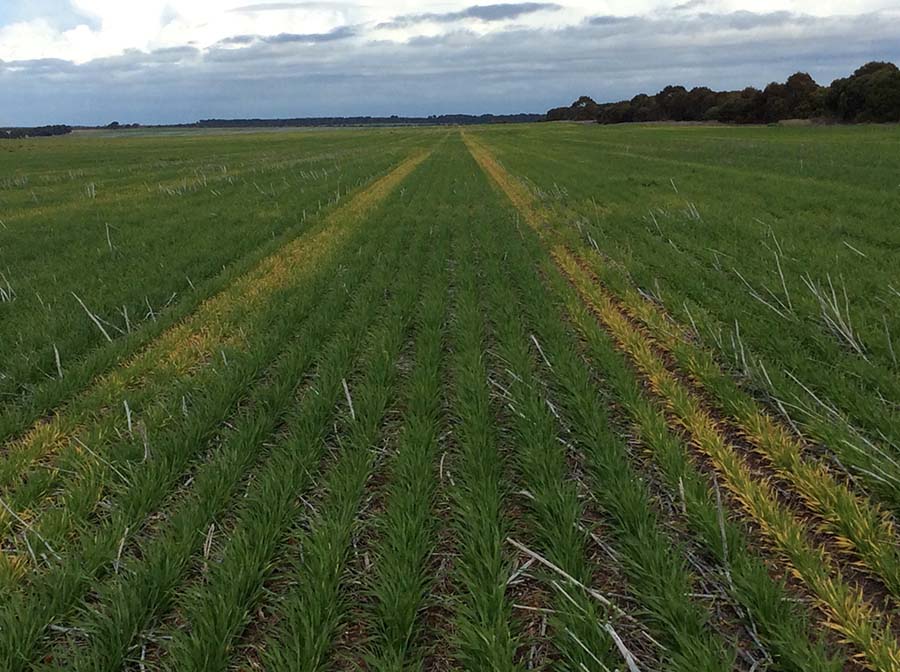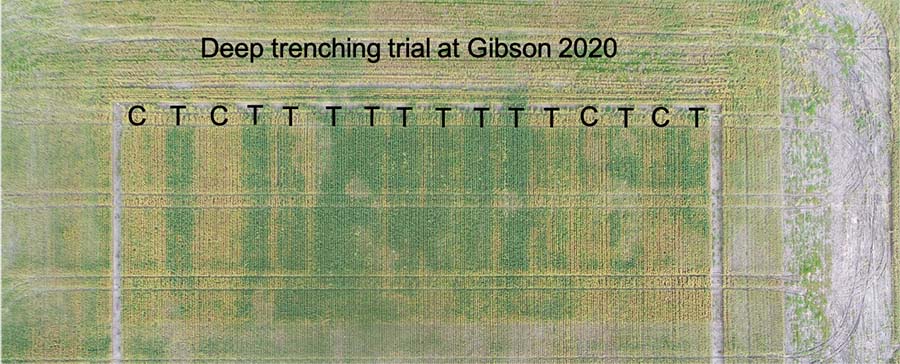Anecdotal evidence from trials and growers suggests that ripping non-dispersive duplex soils can help reduce waterlogging. Plant growth can be improved for a number of reasons including more oxygen in the soil for roots to respire, reduced gaseous losses of nitrogen and better nutrient uptake.
In Western Australia (WA), duplex soils are typically a sandy topsoil overlying a heavier-textured and often dense soil such as a loam or clay. In wet years, water can perch on the subsoil, waterlogging part or all of the topsoil.
Deep ripping is normally used to alleviate agriculturally induced compaction and works well on deep sands and sandy earths where the tynes can work into or below the compacted layer. Responses on duplex soils are more variable.
In duplexes with gravelly subsoils, water may drain well enough without ripping if the matrix around the gravel stones is sandy. Where there is non-dispersive clay in the matrix and/or conglomerate gravel that perches water above it, ripping appears to be beneficial.
Growers who have ripped into non-dispersive duplex soils in the last few years are now seeing benefits from reduced waterlogging.
Ripping impacts on waterlogging
Ripping can reduce waterlogging in a few ways.

Ripped paddock with tramlines waterlogged from compaction. Sandy gravel duplex soil. Photo: Courtesy of Quenten Knight, Agronomy Focus.
Ability to hold more water and air
As ripping busts up dense subsoil it increases soil porosity meaning more spaces for water to fill. This increases the amount of water the soil can hold before it reaches saturation and crop roots start to suffer from wet feet. Every day the soil isn’t saturated there is more oxygen for plant roots and better crop growth.
Lower perched water table
Ripping can also mean that the perched water table sits lower in the profile than it did previously, giving roots a bit more breathing space above.
Better drainage
Ripping can improve drainage by creating channels for water to flow deeper and faster away from the topsoil. This is more likely with inclusion plates where topsoil falling into the rip lines creates seams of sandier soil that act as drains, allowing the water to move deeper and faster into the subsoil, lowering the waterlogging risk.
Drainage improvements from ripping may only be minor, particularly where the landscape is normally prone to waterlogging. Working direction - orientation of run or tram lines - may have more of an effect on drainage. Tramlines that follow natural drainage lines or surface contours help surface water escape better than those that cut across the slopes but can exacerbate erosion.
Risks of ripping duplex soils
Although ripping duplex soils might reduce waterlogging risk, where waterlogging does occur it reduces the longevity of the ripping benefit itself. Ripped waterlogged subsoils tend to collapse under their own weight, reducing soil porosity and setting hard when they dry out. Some growers in waterlogged areas are planning to rip every three years.
Ripping duplex soils can adversely affect trafficability, especially in wet years. Most growers ripping these soils are using controlled traffic farming (CTF) practices which reduces trafficability issues.

The effects of deep tillage in a wet year. C = unripped soil (control); T = ripped soil. Photo: Courtesy of David Hall, DPIRD
Ripping is rarely recommended on duplex soils where the subsoil is dispersive and/or sodic as it can bring clods of hostile soil to the surface. Plus, when it rains the soil disperses and solidifies into a hard mass. Ripping without adding gypsum to treat soil sodicity is only a temporary fix that often brings more issues than benefits.
There is also a limit to the depth tynes can work into dense subsoils. Too deep and you risk bringing big clods to the surface, plus more horsepower and fuel are required, and breakages are more likely. These factors and the nature of the subsoil itself can limit ripping responses and profitability, the longevity of any responses and reductions in waterlogging.
As options to deal with waterlogged soils are limited, GRDC research into sub-surface drainage is underway. The projects in Albany and Esperance will explore the potential return on investment of sub-surface water management options for waterlogged soils. Drains were constructed beginning of 2021 and the trials will run for three growing seasons.
This article was produced as part of the GRDC ‘Maintain the longevity of soils constraints investments and increase grower adoption through extension – western region’ investment.
This project is extending practical findings to grain growers from the five-year Soil Constraints – West suite of projects, conducted by the Department of Primary Industries and Regional Development (DPIRD), with GRDC investment.

























































